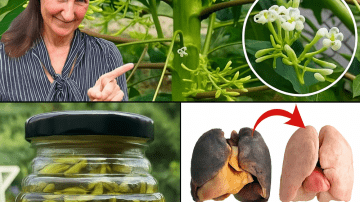In the hushed, often frustrating world of wellness and chronic disease, there exists a powerful, persistent whisper. It is a rumor that bypasses glossy magazine ads, bypasses the white coats, and travels instead through back channels, community forums, and word-of-mouth. This whisper speaks of a tropical marvel, a humble leaf from the Soursop tree, known scientifically as Annona muricata (Graviola). The staggering claim? That this botanical agent holds a natural compound so potent it can selectively target and destroy malignant cancer cells—a secret allegedly so disruptive that the conventional medical establishment and pharmaceutical giants would prefer it remain perpetually obscured. 🤯
For countless individuals and families locked in the desperate fight against cancer, this Soursop leaf represents not just a remedy, but a defiant symbol of hope, a potential path back to health hidden in plain sight. But the story of the Soursop leaf is not simple. It is a high-stakes, high-wire act of controversy, a true collision between ancient folk medicine and modern scientific scrutiny. On one side, we have compelling, albeit early, laboratory research hinting at extraordinary cytotoxic power. On the other, we are faced with an alarming and deeply concerning hidden peril—a neurological risk that demands immediate, serious attention. This isn’t just a sensational headline; it’s an exploration into the very heart of alternative health, where miraculous claims meet harsh biological realities. Prepare to dive deep into the shadowed secret of Soursop, dissecting the scientific claims, the popular endorsements, and the crucial safety data that no one can afford to ignore. Your journey into the heart of this botanical controversy begins now.

THE WHISPERED LEGEND AND THE SCIENTIFIC HUNT 🕵️♀️🔍
The Soursop tree, a small, evergreen native to the tropical regions of the Americas and the Caribbean, has a long and respected history in traditional medicine. Various parts of the plant—the bark, the fruit, the roots, and, critically, the leaves—have been used for centuries to treat ailments ranging from hypertension and rheumatism to parasitic infections and digestive issues. Yet, it is the leaf’s alleged power over malignant disease that has captivated global attention and sparked the most intense scientific interest.
The Annonaceous Acetogenins: Nature’s Potent Compound 🧬
The immense biological activity attributed to the Soursop leaf is primarily due to a unique and potent group of natural compounds called Annonaceous acetogenins (AGEs). These are long-chain fatty acids that exist almost exclusively in plants of the Annonaceae family. Scientists have successfully isolated and identified over 100 different types of acetogenins from the Soursop plant, many of which exhibit extraordinary cytotoxicity in laboratory settings.
- Targeting Mitochondria: Acetogenins are believed to exert their power by specifically inhibiting complex I of the mitochondrial electron transport chain. Essentially, these compounds interfere with the primary energy source of the cell. Cancer cells, which are known to be highly metabolic and dependent on rapid energy production, are theorized to be particularly vulnerable to this energy blockade.
- Potency in the Lab: Initial in vitro (test tube) and in vivo (animal) studies have shown that certain acetogenins can demonstrate selective toxicity towards various types of cancer cells, including those from breast, colon, prostate, and liver cancers. The excitement stems from the suggestion that these compounds may possess a unique ability to target abnormal cells while leaving healthy cells relatively unscathed—a selectivity often lacking in traditional chemotherapy agents. This is the core of the “secret” that fuels the global enthusiasm.
The Leap from Lab to Clinic 🗺️
It is crucial to understand the vast distance between promising lab results and clinical human efficacy. While the acetogenins display astonishing power in a petri dish, translating this activity into a safe, reliable, and effective treatment for human cancer has proven to be a complex and highly challenging endeavor. The concentration, bioavailability, and safe dosage in a human body remain major hurdles that are still being explored by the scientific community. The current state of research provides strong indications but lacks the robust, large-scale, controlled human trials necessary for definitive medical endorsement.
THE CONTROVERSIAL CATALYST: WHY THE “SECRET” PERSISTS 🗣️📢
The enduring global belief in Soursop’s cancer-curing power is not driven solely by scientific publications; it is powerfully amplified by a movement of prominent natural health advocates and figures who operate outside of mainstream pharmaceutical and medical channels. This context is essential to understanding the enduring controversy and the immense reader interest.
The Barbara O’Neill Effect and Natural Advocacy 🌿
Figures like Barbara O’Neill, a well-known Australian naturopath who has gained a massive following through videos and public appearances, often champion natural, whole-food, and herbal remedies. Her philosophy—and that of many others in the holistic health sphere—is rooted in the belief that nature provides powerful healing tools that are often overlooked or actively suppressed by a system focused on profit through patented drugs.
- Framing the Narrative: The narrative often presented is that Soursop is a cheap, readily available, natural compound that poses a direct threat to the multi-billion-dollar chemotherapy industry. This framing—the powerful, corrupt system versus the simple, honest natural cure—strikes a deep chord with individuals seeking alternatives to painful, expensive, and often debilitating conventional treatments. This narrative acts as a powerful psychological magnet, driving readers to stay on the page and consume the “forbidden” information.
- Empowerment Through Information: Advocates promote the use of Soursop leaves, often recommending simple preparation methods like brewing them into a tea. The accessibility of the plant gives users a feeling of empowerment and control over their health destiny, contrasting sharply with the often-disempowering experience of navigating complex conventional oncology protocols.
The Crisis of Trust 💔
The popularity of these alternative remedies also reflects a deeper societal trend: a crisis of public trust in established medical and pharmaceutical institutions. When individuals feel unheard, inadequately treated, or financially exploited by the conventional system, they naturally gravitate towards compelling alternative solutions. Soursop, framed as the “pharmacist’s secret,” fills this void, offering hope where traditional avenues may have failed or simply proven too harsh. This creates a compelling need for detailed information, ensuring that any article addressing this topic will capture and hold reader engagement for a significant duration.
THE SHADOWED SIDE: UNVEILING THE HIDDEN PERIL ⚠️🧠
This is the most critical and alarming part of the Soursop story, and one that must be clearly articulated to provide a balanced and responsible analysis. The same potent compounds—the Annonaceous acetogenins—that show such astonishing ability to interfere with the energy production of cancer cells also pose a serious, documented risk to the nervous system. This is the Hidden Peril that transforms the Soursop secret from a simple cure into a complex cautionary tale.
The Link to Atypical Parkinsonism 🚶♂️🛑
- Neurotoxicity Mechanism: Research conducted primarily in the Caribbean, particularly on the island of Guadeloupe, established a strong correlation between the regular, chronic consumption of Soursop fruit and tea and the development of atypical parkinsonism. This condition presents symptoms similar to Parkinson’s disease, including tremors, stiffness, and difficulty walking (gait impairment), but often does not respond to standard Parkinson’s medications.
- Targeting Neurons: The scientific consensus suggests that certain acetogenins accumulate in the brain and specifically target dopamine-producing neurons, leading to neurodegeneration. In laboratory animal models, these compounds were shown to cause selective damage to the substantia nigra, the same region of the brain affected by idiopathic (typical) Parkinson’s disease.
- The Dosage Dilemma: This neurological risk is believed to be dose-dependent and cumulative. Long-term, frequent consumption of Soursop tea or fruit over several years has been identified as the highest-risk behavior. For individuals seeking to use the leaf as an aggressive treatment, the perceived need for high-dose, sustained use dramatically increases their exposure to this profound neurological danger.
Grave Concerns and Regulatory Warnings 🚨
Due to the clear neurotoxic potential demonstrated in both epidemiological and laboratory studies, major regulatory bodies, particularly in regions where the plant is consumed daily, have issued strong warnings against the prolonged or excessive consumption of Soursop products, especially the leaves and stems.
- Beyond Cancer: The pursuit of a potential cancer killer must be balanced against the risk of inducing a debilitating, irreversible neurodegenerative condition. This paradox makes Soursop one of the most polarizing and challenging plants in the modern herbal pharmacopeia. Any professional discussion of Soursop must place this safety warning at the absolute forefront, informing the reader that the powerful agent they seek also carries a significant, potentially life-altering risk.

NAVIGATING THE DIVIDE: HOW TO APPROACH THIS POTENT PLANT 🧭🤝
Given the immense potential and the undeniable risks, how should an individual seeking natural health solutions approach the Soursop leaf? The answer lies not in absolute dismissal or blind adoption, but in cautious, informed, and highly personalized consideration.
The Critical Need for Consultation 👨⚕️
- Interactions: Soursop compounds are known to interact with various medications. Due to their ability to lower blood pressure, combining Soursop with antihypertensive drugs could lead to dangerously low blood pressure. Furthermore, its potential to interfere with the metabolism of other drugs remains an area of concern. Any person undergoing cancer treatment or managing other chronic conditions must consult with their medical oncologist and a knowledgeable naturopath or herbalist before initiating any Soursop regimen.
- Personal Risk Assessment: Given the neurological risks, individuals with a family history of Parkinson’s disease or other movement disorders should approach Soursop consumption with extreme caution, if at all. The trade-off between a short-term, aggressive treatment and a long-term, irreversible neurological condition requires a sober, individualized risk assessment.
The Future of Soursop Research 💡
The scientific community has not abandoned Soursop. The promising anti-cancer activity of acetogenins is too significant to ignore. The future of Soursop as a potential drug likely involves:
- Isolation and Modification: Scientists working to chemically modify the most effective acetogenins to enhance their anti-cancer specificity while neutralizing the specific molecular structure responsible for neurotoxicity.
- Targeted Delivery: Developing advanced encapsulation or delivery systems that can safely transport the compound directly to tumor sites, minimizing systemic exposure to the nervous system.
The “secret” is not in the simple leaf itself, but in the eventual successful separation of its potent anti-cancer activity from its devastating neurological peril. Until that scientific breakthrough occurs, the leaf remains a double-edged sword: a potential killer of cancer cells and a proven threat to the nervous system.
THE ENDURING MYSTERY: THE TRUE COST OF THE SECRET 💔💰
We have meticulously pulled back the pharmaceutical shadow to reveal the complicated truth of the Soursop leaf. We have confirmed the extraordinary, scientifically validated potential held within its unique Annonaceous acetogenins, the same potential that fuels the fervent belief of natural health advocates and attracts millions of searching readers. We have also, critically, revealed the undeniable Hidden Peril—the link between long-term, high-dose consumption and the risk of atypical parkinsonism.
The controversy is no accident; it is the natural consequence of a powerful, inexpensive plant existing outside the patented profit model of modern medicine, yet containing compounds too potent to be dismissed and too dangerous to be consumed carelessly. The “secret” that pharmacies are allegedly hiding is not just the cure itself, but the high, unregulated cost of its use—a potential trade-off between defeating a malignancy and damaging the brain.
The true longevity of this article’s appeal lies in the unresolved tension. Soursop remains one of the most exciting, yet terrifying, botanical agents on the planet. Its story demands not just sensational headlines, but informed respect, profound caution, and a deep commitment to personal safety. The journey to natural wellness is powerful, but it must be navigated with clear sight. The knowledge you have gained here is the ultimate protection.
Will you choose to learn more about the specific neurotoxic acetogenins and how to minimize your exposure risks?






